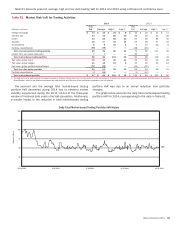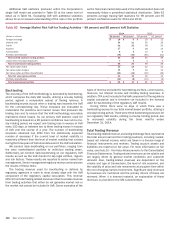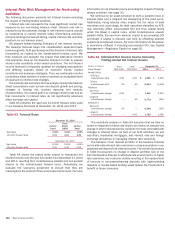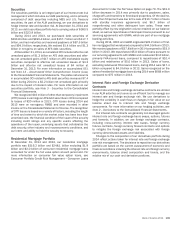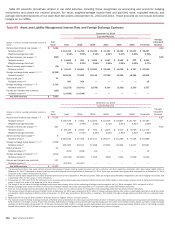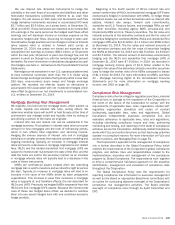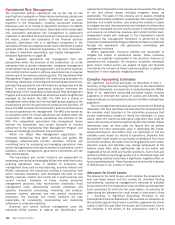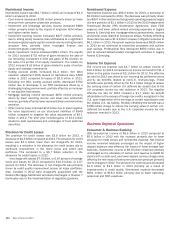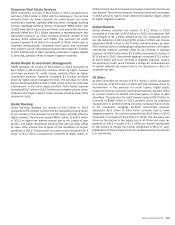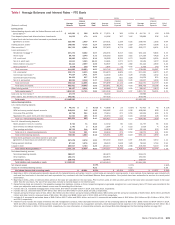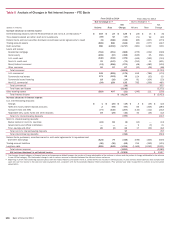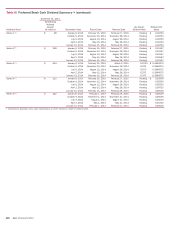Bank of America 2014 Annual Report Download - page 111
Download and view the complete annual report
Please find page 111 of the 2014 Bank of America annual report below. You can navigate through the pages in the report by either clicking on the pages listed below, or by using the keyword search tool below to find specific information within the annual report.Bank of America 2014 109
during 2014, see Note 20 – Fair Value Measurements to the
Consolidated Financial Statements.
Accrued Income Taxes and Deferred Tax Assets
Accrued income taxes, reported as a component of either other
assets or accrued expenses and other liabilities on the
Consolidated Balance Sheet, represent the net amount of current
income taxes we expect to pay to or receive from various taxing
jurisdictions attributable to our operations to date. We currently
file income tax returns in more than 100 jurisdictions and consider
many factors, including statutory, judicial and regulatory guidance,
in estimating the appropriate accrued income taxes for each
jurisdiction.
Consistent with the applicable accounting guidance, we monitor
relevant tax authorities and change our estimate of accrued
income taxes due to changes in income tax laws and their
interpretation by the courts and regulatory authorities. These
revisions of our estimate of accrued income taxes, which also may
result from our income tax planning and from the resolution of
income tax controversies, may be material to our operating results
for any given period.
Net deferred tax assets, reported as a component of other
assets on the Consolidated Balance Sheet, represent the net
decrease in taxes expected to be paid in the future because of
net operating loss (NOL) and tax credit carryforwards and because
of future reversals of temporary differences in the bases of assets
and liabilities as measured by tax laws and their bases as reported
in the financial statements. NOL and tax credit carryforwards result
in reductions to future tax liabilities, and many of these attributes
can expire if not utilized within certain periods. We consider the
need for valuation allowances to reduce net deferred tax assets
to the amounts that we estimate are more-likely-than-not to be
realized.
While we have established valuation allowances for certain
state and non-U.S. deferred tax assets, we have concluded that
no valuation allowance was necessary with respect to all U.S.
federal and U.K. deferred tax assets, including NOL and tax credit
carryforwards, that are not subject to any special limitations (such
as change-in-control limitations) prior to any expiration.
Management’s conclusion is supported by financial results and
forecasts, the reorganization of certain business activities and the
indefinite period to carry forward NOLs. The majority of U.K. net
deferred tax assets, which consist primarily of NOLs, are expected
to be realized by certain subsidiaries over an extended number of
years. However, significant changes to our estimates, such as
changes that would be caused by substantial and prolonged
worsening of the condition of Europe’s capital markets, or to
applicable tax laws, such as laws affecting the realizability of NOLs
or other deferred tax assets, could lead management to reassess
its U.K. valuation allowance conclusions. See Note 19 – Income
Taxes to the Consolidated Financial Statements for a table of
significant tax attributes and additional information. For more
information, see Item 1A. Risk Factors of our 2014 Annual Report
on Form 10-K.
Goodwill and Intangible Assets
Background
The nature of and accounting for goodwill and intangible assets
are discussed in Note 1 – Summary of Significant Accounting
Principles and Note 8 – Goodwill and Intangible Assets to the
Consolidated Financial Statements. Goodwill is reviewed for
potential impairment at the reporting unit level on an annual basis,
which for the Corporation is as of June 30, and in interim periods
if events or circumstances indicate a potential impairment. A
reporting unit is an operating segment or one level below. As
reporting units are determined after an acquisition or evolve with
changes in business strategy, goodwill is assigned to reporting
units and it no longer retains its association with a particular
acquisition. All of the revenue streams and related activities of a
reporting unit, whether acquired or organic, are available to support
the value of the goodwill.
For purposes of goodwill impairment testing, the Corporation
utilizes allocated equity as a proxy for the carrying value of its
reporting units. Allocated equity in the reporting units is comprised
of allocated capital plus capital for the portion of goodwill and
intangibles specifically assigned to the reporting unit. The goodwill
impairment test involves comparing the fair value of each reporting
unit with its carrying value, including goodwill, as measured by
allocated equity. During 2014, the Corporation made refinements
to the amount of capital allocated to each of its businesses based
on multiple considerations that included, but were not limited to,
risk-weighted assets measured under the Basel 3 Standardized
and Advanced approaches, business segment exposures and risk
profile, and strategic plans. As a result of this process, in 2014,
the Corporation adjusted the amount of capital being allocated to
its business segments. This change resulted in a reduction of the
unallocated capital, which is reflected in All Other, and an aggregate
increase to the amount of capital being allocated to the business
segments. An increase in allocated capital in the business
segments generally results in a reduction of the excess of the fair
value over the carrying value and a reduction to the estimated fair
value as a percentage of allocated carrying value for an individual
reporting unit.
The Corporation’s common stock price improved during 2014;
however, its market capitalization remained below its recorded
book value. We estimate that the fair value of all reporting units
with assigned goodwill in aggregate as of the June 30, 2014 annual
goodwill impairment test was $307.1 billion and the aggregate
carrying value of all reporting units with assigned goodwill, as
measured by allocated equity, was $175.7 billion. The common
stock capitalization of the Corporation as of June 30, 2014 was
$161.6 billion ($188.1 billion at December 31, 2014). As none
of our reporting units are publicly traded, individual reporting unit
fair value determinations do not directly correlate to the
Corporation’s stock price. Although we believe it is reasonable to
conclude that market capitalization could be an indicator of fair
value over time, we do not believe that our current market
capitalization reflects the aggregate fair value of our individual
reporting units.


